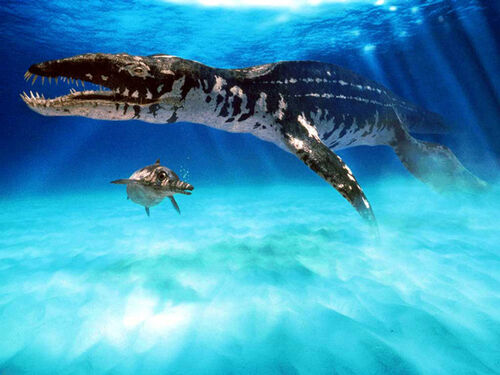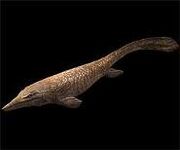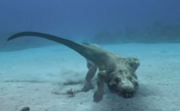
Liopleurodon

An opthalmosaurus avoids a liopleurodon on WWD
Since the start of the Mesozoic era, several clans of reptiles (none of which were dinosaurs), colonized the seas with various levels of success. Marine crocodiles and sea turtles are the only ones who have even remotely made it to our day (the crocodiles are represented by a single ocean-going species - the modern saltwater crocodile of the Indo-Pacific region), however. Both of these groups of reptiles were shown in the last episode of Sea Monsters, as sleek fish-hunting predators and bulkier, gentler giants of the Mesozoic seas, respectively.
Three major groups became fully aquatic: the ichthyosaurs, the sauropterigians, and the mosasaurs. They all belonged to different parts of the sauropsid family tree.
Both the ichthyosaurs and the sauropterigians appeared in the early Triassic period (shown in the first episode of Sea Monsters), and quickly took over the dominant role of the aquatic predators. They became so adapted to living in the seas, that they become viviparous, giving birth to live young, analogous to the modern whales. This was demonstrated by the Ophthalmosaurus ichthyosaur in the 3rd episode of Walking with Dinosaurs, "Cruel Sea", alongside the differences of these late Jurassic ichthyosaurs (149 MYA) as opposed to the earlier species, such as Cymbospondylus: the former genus had much compact, dolphin-like body shapes, and were no longer the dominant marine reptiles - that role went to Liopleurodon and other pliosaurs. Some of these pliosaurs, judging from

the skull recently discovered, were huge, possibly as big as depicted in Impossible Pictures or perhaps even bigger.
Unlike the ichthyosaurs, the nothosaurs of the Triassic were less aquatic and could move on land, just like modern crocodiles or sea otters. They had fully functioned feet, albeit webbed. By the late Jurassic, however, the nothosaurs had disapeared. Despite this, their relatives, the plesiosaurs, where stilla round and thriving. They couldn't move on land, but they where ht edominent predaotrs in the form of pliosaurs. By late Cretaceous (65 MYA), the last plesiosaurs such as Elasmosaurus where still around. The last episode of Sea Monsters features a pack of these animals, explaining that the plesiosaurs used their long necks to ambush small fish on which they fed on.

In addition to long-necked plesiosauroids (One half of the pesiosauria, see above.), there were also the pliosaurs, who dominated the seas

of the late Jurassic and early Cretaceous. Plesiopleurodon, briefly featured in the fourth episode of Walking with Dinosaurs, was one of the last members of this clan; by the end of the Cretaceous (65 MYA) their role was taken over by the mosasaurs.
They - the mosasaurs - were related to the ancestors of the monitor lizards and snakes, and like them they were predators, swimming mainly by the ungulations of their tails and bodies, rather than with fins, like the plesiosaurs. However, they died out in the end of the Mesozoic, just like the other giant marine reptiles, dinosaurs and pterosaurs, leaving only the modern sea snakes and the marine iguana lizards of the Galapagos islands (alongside the saltwater crocodile and the modern sea turtles) as the only remnants of that dynasty.
